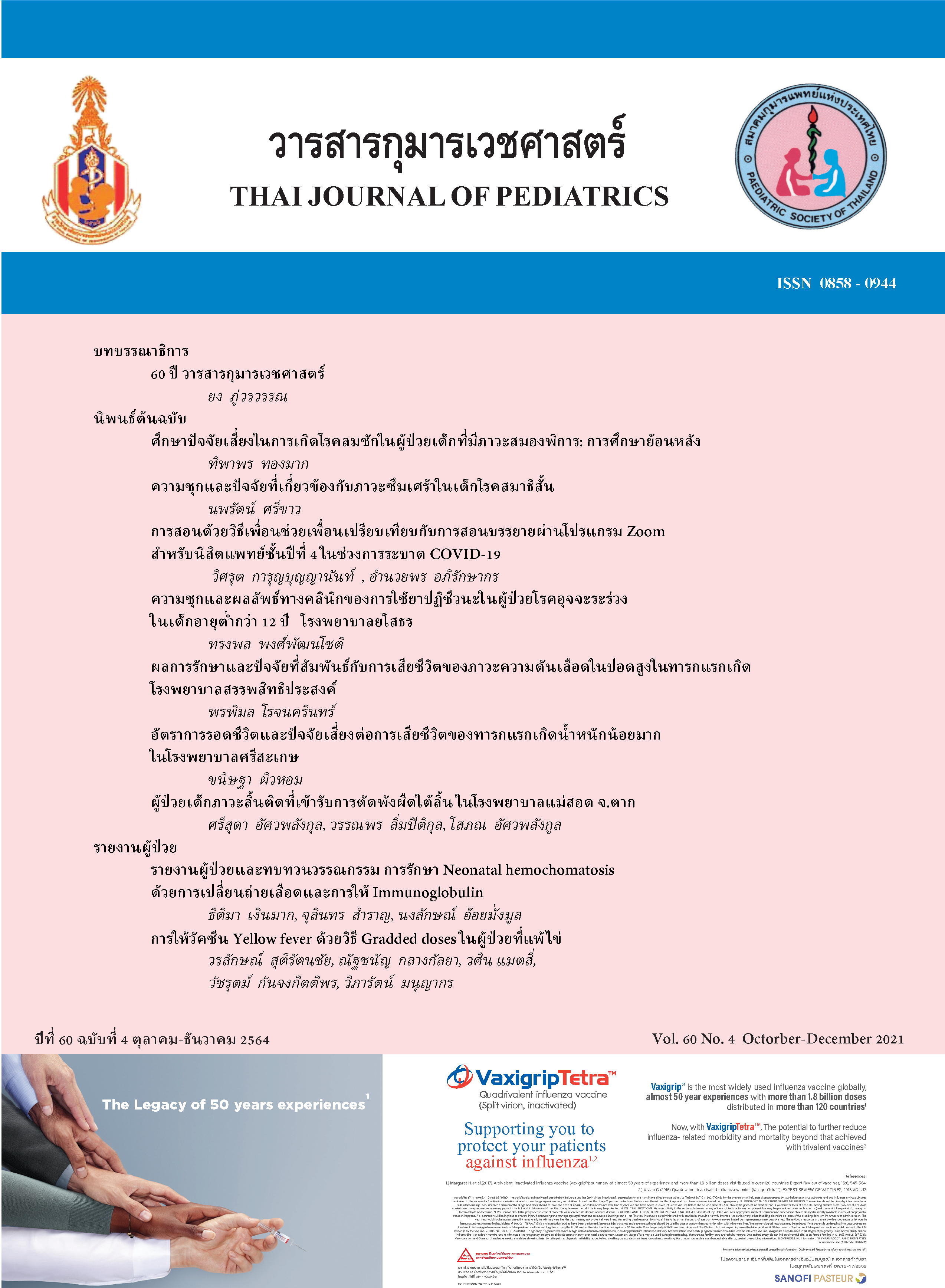ผู้ป่วยเด็กภาวะลิ้นติดที่เข้ารับการตัดพังผืดใต้ลิ้นในโรงพยาบาลแม่สอด จ.ตาก
คำสำคัญ:
ภาวะลิ้นติด, แนวโน้ม, การตัดพังผืดใต้ลิ้น, การถูกตรวจพบบทคัดย่อ
ความเปืนมา: ลิ้นติด (Tongue tie, Ankyloglossia, short lingual frenulum) เป็นภาวะที่พบส่วนของพังผืดใต้ลิ้น (Lingual fenulum) ยึดตามแนวยาวถึงสันเหงือกหรือถึงปลายลิ้้นสั้น ตึงหรือหนาทำให้การเคลื่อนไหวของลิ้นลดลง และมีผลกระทบต่อการเลี้ยงถูกด้วยนมแม่ และมีผลต่อพัฒนาการพูด
ในภายหลัง ปัจุบันมีเกณฑ์วินิจฉัยหลายแบบ ทำให้แนวทางการรักษามีความแดกด่างกัน บทบาทของกุมารแพทย์ในโรงพยาบาลแม่สอดในการดูแลรักษาภาวะลิ้นติดในทารกแรกเกิดเริ่มมีเพิ่มมากขึ้นและทำการตัดพังผืดใต้ลิ้นตั้งแต่ยังอยู่ในช่วงทารกแรกเกิด
วัตถุประสงค์: เพื่อศึกษาทิศทาง แนวโน้ม และลักษณะผู้ป่วยเด็กภาวะลิ้นติดที่เข้ารับการตัดพังผืดใด้ลิ้นในโรงพยาบาลแม่สอด
วิธีดำเนินการวิจัย: ศึกษาแบบ Rectrospective cohort ในผู้ป่วยเด็กมีภาวะลิ้นติดที่มารับการรักษาโดยการตัดพังผืดใต้ลิ้นที่โรงพยาบาลแม่สอดระหว่างปี พ.ศ. 2556-2562 รวบรวมข้อมูลจากบันทึกเวชระเบียนผู้ป่วยใน วิเคราะห์ข้อมูลทั่วไปใช้ความถี่ ร้อยละ ค่ามัธยฐาน ค่พิสัยสูงสุด-ต่ำสุด
ผลการศึกษา: จำนวนผู้ป่วยที่ เข้ารับการตัดพังผืดใช้ลิ้นในโรงพยาบาลแม่สอดระหว่างปี พ ศ. 2556-2562 จำนวน 171 ราย และมีแนวโน้มเพิ่มขึ้นโดยพบร้อยละ 22.22 ในปี พ.ศ. 2561 (38/171) และร้อยละ 32.16(55/171) ในปี พ.ศ. 2562 ผู้ป่วยร้อยละ 60.2 เป็นชาย (ชาย:หญิง =1.5:1) เป็นคนไทยร้อยละ 72.5
อายุของผู้ป่วยมีค่ามัธยฐานเท่ากับ 8.8 เดือน (พิสัย: 9 ชั่วโมง, 12.2 ปี]ร้อยละ 88.9 คลอดในโรงพยาบาลและร้อยละ 76.6 ของผู้ป่วยทั้งหมดคลอดปกติ อาการสำคัญที่นำมาสู่การตัดพังผืดใต้ลิ้นร้อยละ 33.9 ผู้ป่วยมีอาการแลบลิ้นไม่ได้ ไม่แลบลิ้น แลบลิ้นไม่สุด ผู้ป่วยประมาณร้อยละ 33.9 ถูกตรวจพบโดยกุมารแพทย์ตั้งแต่ช่วงแรกเกิดในโรงพยาบาล และอีกประมาณร้อยละ 10.0 ถูกวินิจฉัยเป็นภาวะรองในเวลาต่อมาผู้ป่วยทั้งชาวไทยและต่างชาติที่เกิดในปี พ.ศ. 2557-2562 มีแนวโน้มได้รับการตัดพังผืดใด้ลิ้นจำนวนเร็วขึ้นโดยพบว่าผู้ป่วยที่เกิดในปี พ.ศ. 2560 มีค่ามัธยฐานอายุที่ตัดพังฝืดใด้ลิ้นเท่ากับ 5.07 เดือน(พิสัย: 20 ชั่วโมง, 2.01 ปี) ผู้ป่วยที่เกิดปี พ.ศ. 2561 มีคำามัธยฐานอายุที่ตัดพังพืดใต้ลิ้นเท่ากับ 84 ชั่วโมง(พิสัย: 10ชั่วโมง, 1.65 ปี] และผู้ป่วยที่เกิดปี พ.ศ. 2562 มีค่ามัธยฐานอายุที่ตัดพังผืดได้ลิ้นเท่ากับ 72 ชั่วโมง(พิสัย: 8 ชั่วโมง, 29 วัน]
สรุป: การตัดพังผืดใต้ลิ้นในผู้ป่วยเด็กกาวะลิ้นดิดที่เข้ารับการรักษาในโรงพยาบาลแม่สอดมีแนวโน้มเพิ่มมากขึ้นและทำเร็วขึ้นคือทำในช่วงทารกแรกเกิด
Downloads
เอกสารอ้างอิง
LawrenceRA, LawrenceRM.Breastfeeding: a guide for the medical profession In: RM L, editor. Protocal II: Guidelines for the
evaluation and management of neonatal ankyloglossia and its complications in the breastfeeding dyad. 8th ed. Missouri: Mosby:
Elsevier; 2015. p. 1025-39.
Dollberg S, Botzer E. [Neonatal tongue-tie: myths and science]. Harefuah. 2011;150: 46-9, 67.
Sethi N, Smith D, Kortequee S, Ward VM, Clarke S. Benefits of frenulotomy in infants with ankyloglossia. Int J Pediatr Otorhinolaryngol. 2013;77:762-5.
Walsh J, McKenna Benoit M.Ankyloglossia and Other Oral Ties. Otolaryngologic Clinics of North America. 2019;52:795-811.
Ferres-Amat E, Pastor-Vera T, RodriguezAlessi P, Ferres-Amat E, MarequeBueno J, Ferres-Padro E. The prevalence of ankyloglossia in 302 newborns with breastfeeding problems and sucking difficultiesin Barcelona: a descriptive study. Eur J Paediatr Dent. 2017;18:319-25.
Balla r d JL, Auer CE, Khoury JC. Ankyloglossia: assessment, incidence, and effect of frenuloplasty on the breastfeeding dyad. Pediatrics. 2002;110(5):e63.
Puapornpong P, Raungrongmorakot K, Mahasitthiwat V, Ketsuwan S. Comparisons of the latching on between newborns with tongue-tie and normal newborns. J Med Assoc Thai. 2014;97:255-9.
ประสงค์วิทยถาวรวงศ์. ลิ้นติด: ปัญหาอย่าง หนึ่งของการเลี้ยงลูกด้วยนมแม่ และการพูดประสบการณ์แก้ไข14 ปีในโรงพยาบาลเพชรบูรณ์.วารสารกุมารเวชศาสตร์. 2560;56(3):237-43.
N g e r n c h am S , Laohapensang M , Wongvisutdhi T, Ritjaroen Y, Painpichan N, Hakularb P, et al. Lingualfrenulum and effect
on breastfeeding in Thai newborn infants. Paediatr Int Child Health. 2013;33:86-90.
Ata N,Alatas N,Yilmaz E,AdamAB, Gezgin B. The Relationship of Ankyloglossia With Gender in Children and the Ideal Timing of
Surgery in Ankyloglossia. Ear Nose Throat J. 2019:145561319867666.
MessnerAH, Lalakea ML,Aby J, Macmahon J, Bair E. Ankyloglossia: incidence and associated feeding difficulties. Arch Otolaryngol Head Neck Surg. 2000;126:36-9.
Henry L, Hayman R. Ankyloglossia and Its Impact on Breastfeeding. Nursing for Women’s Health. 2014;18:122-9.
Wong K, Patel P, Cohen MB, Levi JR. Breastfeeding Infants with Ankyloglossia: Insight intoMothers’Experiences.Breastfeed Med. 2017;12:86-90.
Kaplan M, Wong RJ, Burgis JC, Sibley E, Stevenson DK. Neonatal jaundice and liver diseases. In: Martin RJ, Fanaroff AA, Walsh MC, editors. Fanaroff & Martin’s NeonatalPerinatal Medicine: diseases of the fetus and infant. 2. 11th ed. Philadelphia: Elsevier;2020. p. 1788-852.
Daggumati S, Cohn JE, Brennan MJ, Evarts M, McKinnon BJ, Terk AR. Speech and Language Outcomes in Patients with Ankyloglossia Undergoing Frenulectomy: A Retrospective Pilot Study. OTO Open. 2019;3:2473974X19826943.
Chinnadurai S, Francis DO, Epstein RA, Morad A, Kohanim S, McPheeters M. Treatment of ankyloglossia for reasons other than breastfeeding: a systematic review. Pediatrics. 2015;135:e1467-74.
Messner AH, Lalakea ML. Ankyloglossia: controversies in management. Int J Pediatr Otorhinolaryngol. 2000;54:123-31.
Moore KL, Persaud TVN, Torchia MG. Pharyngeal apparatus, face, and neck. In: Moore KL, Persaud TVN, Torchia MG, editors. The developing human: Clinically oriented embryology. 10th ed. Philadelphia: Elsevier; 2016. p. 155-94.
Webb AN, Hao W, Hong P. The effect of tongue-tie division on breastfeeding and speech articulation: a systematic review. Int J Pediatr Otorhinolaryngol. 2013;77:635-46.
Ga ne sa n K, Girgis S, Mitchell S. Ankyloglossia. Dental Abstracts. 2020;65:52-3.
Bin-Nun A, Kasirer YM, Mimouni FB. A Dramatic Increase in Tongue Tie-Related Articles: A 67 Years Systematic Review. Breastfeed Med. 2017;12:410-4.
Ganesan K, Girgis S, Mitchell S. Lingual frenotomy in neonates: past, present, and future. British Journal of Oral and Maxillofacial Surgery. 2019;57:207-13.
Power RF, Murphy JF. Tongue-tie and frenotomy in infants with breastfeeding difficulties: achieving a balance. Arch Dis Child. 2015;100(5):489-94.
Buck LS, Frey H, Davis M, et al. Characteristics and considerations for children with ankyloglossia undergoing frenulectomy for dysphagia and aspiration. American Journal of Otolaryngology. 2020;41:102393.
Douglas P. Making Sense of Studies That Claim Benefits of Frenotomy in the Absence of Classic Tongue-Tie.J Hum Lact. 2017;33:519-23
ดาวน์โหลด
เผยแพร่แล้ว
รูปแบบการอ้างอิง
ฉบับ
ประเภทบทความ
สัญญาอนุญาต

อนุญาตภายใต้เงื่อนไข Creative Commons Attribution-NonCommercial-NoDerivatives 4.0 International License.



